Timing is everything. In the case of Livingstone Falls Provincial Recreation Area that means two things. One, use it while you can. As one of the 164 properties the current provincial government is slated to remove from the parks system, 2020 was (likely) the last summer for camping here (it will remain a day use area). And two, late July is fly season (more on this later).
As luck would have it, the summer of 2020 is screwed up in many ways, all of which conspired to facilitate a couple nights of camping at Livingstone Falls before it’s gone. The campground, not the falls. Though one can never be too sure with politicians.
As an entirely first come, first served campground, with only twenty-two sites and forty-two kilometres of gravel road to get there, Livingstone Falls is exactly the kind of campground we’d normally never frequent. But with only my son and I going, using a tent, in the early part of the week, it was a perfect time to give it a try.
We didn’t get off to a good start. The consensus route for getting to Livingstone Falls Provincial Recreation Area from Calgary is to head south to Longview, take HWY 541 west to Highwood House at the junction with HWY 40, and head south on the gravel Forestry Trunk Road, also known as HWY 40 … and HWY 940 … and Range Road 53A … and Range Road 52A … and Township Road 154A … and Range Road 51A … and Township Road 144A … and Township Road 143A … and Range Road 42A … and Range Road 41A … and Range Road 40A … you following this?
Fancying myself a rebel of sorts when safely isolated in my vehicle, I decided we’d choose the path less recommended by Google Maps and instead drove south from Longview to the north end of Chain Lakes. There, we headed west on HWY 532 also known as … HWY 532. It too, a gravel road, HWY 532 meets HWY 40 (etc.) just ten kilometres north of the campground.
It was a sound plan. Ah, but not all gravel roads are created equal. The first fifteen or so kilometres of HWY 532 were normal enough. Reasonably maintained with a few Texas gates, I felt few regrets with my decision. It went downhill from there.
Maintenance is not a priority on this road judging by the disappearing gravel topping the further westward we ventured. Soon we were stumbling along on what looked more like a hardpacked, temporary logging road. If washboard gravel roads cause you angst, this boulder injected debacle will leave you with PTSD. It was nuts. There is no way, NONE, that our trailer would have survived this route. As it was, our SUV endured a significant beating.
And yet, others were using this road. Several of them based on the swarm of parked vehicles (cars included!) at a trailhead that I must admit looked pretty sweet. Nonetheless, my son and I both vowed to return home the way God Google intended. Whatever advantage I assumed this route would provide, it was thoroughly debunked. Lesson learned.
Livingstone Falls Provincial Recreation Area is comprised of a small campground, a small day use area, and a small parcel of land tucked between the road and Livingstone River. Aside from a 1 km exclusion zone, it is surrounded by crown land known as the Livingstone Public Land Use Zone. And with crown land comes quads and other motorized entertainment vehicles.
We were camping here on a mid-summer Monday through Wednesday and while the area was certainly not overrun with crown land campers, they were visible everywhere we explored. As for noise, we would hear some quads head out in the morning and then return with some flourish around nine in the evening.
With plentiful OHV trails taking them deep into the mountains, I can’t say I heard or noticed them at all during the day. And the crown land campers we encountered while hiking were quiet and kept to themselves, save for the odd excitable dog. Perhaps this is anomalous compared to busier, more rambunctious weekends, but it was a relief not to be inundated with nonsense.
This, of course, begged the question; what is the point of paying $24 a night to be in the campground when free camping is everywhere around us? Livingstone Falls is entirely first come, first served with self-registration only. It contains a day use “area”, so people are coming and going at will without camping. And in the 48 hours we were there, we only saw an AB Parks pickup truck once for a grand total of about ten minutes.
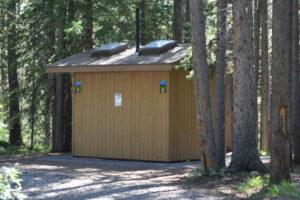 I surmise that I paid $24 for the privilege of pit toilets and nothing much else. That’s a hefty price for the opportunity to smell the accumulated waste of untold numbers of strangers while I add to the excretory buffet. When those same pit toilets are besieged with hundreds of living (and dead) big, buzzing flies, it’s a damned disgrace! Also explains the two campers who had portable outhouse tents onsite.
I surmise that I paid $24 for the privilege of pit toilets and nothing much else. That’s a hefty price for the opportunity to smell the accumulated waste of untold numbers of strangers while I add to the excretory buffet. When those same pit toilets are besieged with hundreds of living (and dead) big, buzzing flies, it’s a damned disgrace! Also explains the two campers who had portable outhouse tents onsite.
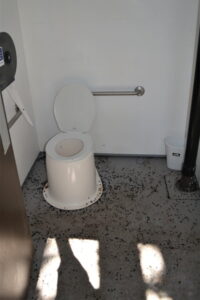 That visiting AB Parks pickup? It had a water tank in the back with pump and hose that the driver used to briefly spray the fly carcases out the door to be left in a pile at the entrance. That minimal maintenance made little difference in my eagerness to use these facilities. I instead made friends with nature behind our site whenever I needed to pee. As for my rear end, let’s just say fly infestations are an effective Imodium alternative.
That visiting AB Parks pickup? It had a water tank in the back with pump and hose that the driver used to briefly spray the fly carcases out the door to be left in a pile at the entrance. That minimal maintenance made little difference in my eagerness to use these facilities. I instead made friends with nature behind our site whenever I needed to pee. As for my rear end, let’s just say fly infestations are an effective Imodium alternative.
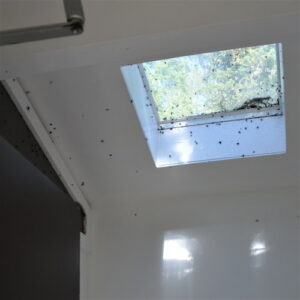 While I’m on this subject, how is it that in 2020 we still provide no means of escape for stupid insects in structures like outhouses? We install bloody skylights that lure all the flying critters upwards but leave no means for them to escape. Instead we shake our heads in disbelief that a dime-sized bug can’t figure out how to use the door. I’m not sure who the idiots are in this scenario.
While I’m on this subject, how is it that in 2020 we still provide no means of escape for stupid insects in structures like outhouses? We install bloody skylights that lure all the flying critters upwards but leave no means for them to escape. Instead we shake our heads in disbelief that a dime-sized bug can’t figure out how to use the door. I’m not sure who the idiots are in this scenario.
Perhaps this is why the campground at Livingstone Falls is on the chopping block. Odd, considering a place like this must be a small cash cow (a cash calf?) with little return in service to campers for the $24 per night. With endless free alternatives literally surrounding the place, “what’s the point” becomes a legitimate question.
That’s a shame because outside of the fly issue, which surely is seasonal, Livingstone Falls Provincial Recreation Area was a delightful little campground. My son and I had a fabulous time. If it were up to me, I’d be increasing the budget for this little gem rather than giving up on it.
There are two loops of campsites, ten in the River Loop and twelve in the Upper Loop. The Upper Loop is elevated with respect to the River Loop but it’s more slope than cliff and several trails have been beaten into the earth from the former down to the latter.
The majority of campsites are fully within pine and spruce forest. The first four or five sites in the River Loop are more open, backing onto trees but otherwise unsheltered. All the sites in both loops are large and well-spaced giving a fair amount of privacy from neighbours. A couple in the River Loop even back onto the river itself.
We chose site 17 in the Upper Loop which was fabulous. Having only 1 direct neighbour (which remained empty during our stay) and endless wilderness behind us, the site was spacious with excellent spots for our tent. And the gravel pad wasn’t so thick with rock that tent pegs couldn’t be pounded into the ground. I even got the big, yellow, plastic kind in for the dining tent, which is a very rare occurrence.
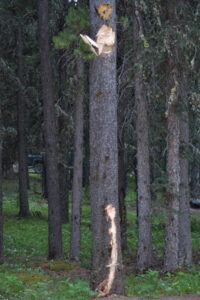 RVs would have little trouble finding room here as well. That being said, while our site and several others are ideally sized for larger trailers, the loop roads can be tight. A tree directly across from our site showed fresh wounds from an RV that had difficulty making the curve. I can’t imagine the owner was thrilled with what the tree did do his camper.
RVs would have little trouble finding room here as well. That being said, while our site and several others are ideally sized for larger trailers, the loop roads can be tight. A tree directly across from our site showed fresh wounds from an RV that had difficulty making the curve. I can’t imagine the owner was thrilled with what the tree did do his camper.
As usual in campgrounds like this, there are no services at sites. None. Fresh water is available from two hand pumps, one in each loop, both advertising a warning about drinking the water. The river itself is a third option and the one we resorted to for our cooking and cleaning water since the pump directly across from our site didn’t work. Not for us, anyway. A far more patient camper got water out of it, but I’ll be damned if I know how he did it. The River Loop pump worked fine.
 With no electricity, generators can sometimes become an issue. We didn’t hear any during our stay. Phew! But we weren’t necessarily there during “peak generator” days. Whether this becomes a problem, either within the campground itself or, god forbid, from nearby crown land campers, is unknown to me.
With no electricity, generators can sometimes become an issue. We didn’t hear any during our stay. Phew! But we weren’t necessarily there during “peak generator” days. Whether this becomes a problem, either within the campground itself or, god forbid, from nearby crown land campers, is unknown to me.
There are three pit toilets in the campground, and you know all too much about them already. If you’re doing your business in your trailer, there is no dump station here. The closest one would be at Highwood House, 42km to the north. Or at Chain Lakes Provincial Park, I suppose. But that would require a trip on the crazy road.
 A registration kiosk with information board is located at the entrance prior to the road splitting between the loops. It’s a straightforward task to claim your site.
A registration kiosk with information board is located at the entrance prior to the road splitting between the loops. It’s a straightforward task to claim your site.
Research online suggests they sold wood here at one time. There’s an abandoned concrete slab next to site 1 which was perhaps where those sales were conducted from. That no longer happens, so like the crown land campers all around you, be sure to bring your own wood.
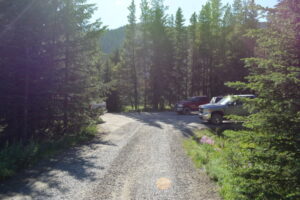 There is a day use area at Livingstone Falls. Even a sign directing you to this day use area. But by all accounts, the day use area is nothing more than a parking lot enabling day users to park and walk down to the falls. There are no day use picnic spots like those normally found at day use areas. Which is fine. Just don’t come here expecting to cook a lunch over a fire and eat from a picnic table.
There is a day use area at Livingstone Falls. Even a sign directing you to this day use area. But by all accounts, the day use area is nothing more than a parking lot enabling day users to park and walk down to the falls. There are no day use picnic spots like those normally found at day use areas. Which is fine. Just don’t come here expecting to cook a lunch over a fire and eat from a picnic table.
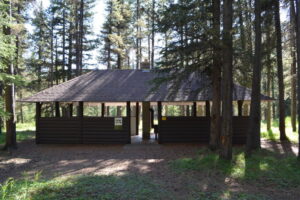 There is a large picnic shelter relatively close to the day use parking lot, but it could just as easily be used by campers as day users. Nothing suggests it is specifically for one or the other group. It is a robust, open wood shelter containing a metal woodstove and two of the biggest freakin’ picnic tables I’ve ever seen. These are monsters! The other half of the space is empty. None of it appears to have been used in some time.
There is a large picnic shelter relatively close to the day use parking lot, but it could just as easily be used by campers as day users. Nothing suggests it is specifically for one or the other group. It is a robust, open wood shelter containing a metal woodstove and two of the biggest freakin’ picnic tables I’ve ever seen. These are monsters! The other half of the space is empty. None of it appears to have been used in some time.
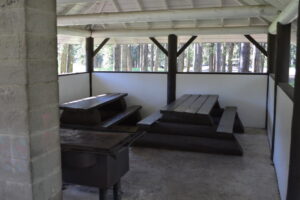 Not surprisingly, there is no cell service way out here in the boonies. There’s nothing wrong with that, and some will prefer it. Just be sure to come prepared and let someone know where you’ve gone. There is no old pay phone at the campground nor is there a store or office or campground host. It’s just you, your wits, and other campers to help out in emergencies. A fun way to camp if you’re up for it.
Not surprisingly, there is no cell service way out here in the boonies. There’s nothing wrong with that, and some will prefer it. Just be sure to come prepared and let someone know where you’ve gone. There is no old pay phone at the campground nor is there a store or office or campground host. It’s just you, your wits, and other campers to help out in emergencies. A fun way to camp if you’re up for it.
No playground either. Or any field on which to play catch. This is not that kind of campground anyway. The river is plenty fun though. If you’re brave, there are some great, deep swimming holes to slip into. And that sandstone slope, where wet, make a fun, if dangerous, waterslide. But for in-campground recreation to send the kids too while you prep meals? Nope.
As for the namesake falls, good grief Albertans are generous with the term “falls.” In no way is this a waterfall, which is what most people think of when they read the word “falls.” As is commonplace in these parts, the falls are just rapids. Pretty, yes, but not a waterfall.
Next to the campground, Livingstone River, your typical Rocky Mountain river, splits in two to embrace a small island. The main course of the river follows a lower path away from the campground and, as mentioned, is nothing but rapids. The secondary river course follows an upper path, close to the campground, that might … just maybe … look like a waterfall … sometimes.
This upper route had limited waterflow in late July. During peak spring flood, it very well could be quite the torrent of water making a reasonable, if small, waterfall. That would also make it a far more dangerous spot to explore, so be forewarned if you come early in the season and the river is running high.
The upper route flows along, and eventually down, a tilted outcrop of hard, beige sandstone. This feature continues several tens of metres to the south and when the two river paths rejoin, the river continues to flow against this dramatic feature. It’s quite cool and makes up for the underwhelming “falls.” As a geologist, I was fascinated with this extended outcrop and enjoyed walking along it.
It is no secret that the river must flow deeper and stronger during flood season. Dead trees are piled up in rocky nooks all along the river and in the falls. Even in the forest, above the banks, tree trunks and debris are seen jammed onto living trees. This may not be a yearly occurrence, but it is evidence enough that it does happen. It’s neat, even if it looks unkempt.
Upstream and downstream of Livingstone Falls Provincial Recreation Area, the Livingstone River is a small, rushing, mountain river with gravel and boulder bars adorning its banks. In some places, bedrock outcrops abruptly divert the river, but overall, it flows form north to south quite continuously. Many of the crown land hotspots are along the river and there are plenty of places to investigate it.
As dedicated rockhounds, my son and I spent hours scouring these river bars looking for fossil treasures. Unfortunately, the area is almost barren. We literally only found a single large rock with a single fossil in it. It’s always a crapshoot in the river rocks and glacial erratics of Rocky Mountain rivers, but this was surely the worst luck we’ve had.
We even explored abroad, out into an unused crown land camping area high above the river. We scaled our way down to the river onto a large bar abandoned against a shaly cliff face. Even in here, hammering away at the friable outcrop, nothing fossiliferous could be found. Nor was there any flour gold in the river (we panned it), despite the abundance of black sands seemingly everywhere.
The lack of geological reward was disappointing, but the entire area is still wonderful to explore. There are some excellent views to be found and investigating the river, despite its dearth of treasure, held our interest the entire trip.
Fly fishing is popular here and we saw several folks casting into the cold, clear river. We even saw one lucky angler with evidence of a catch. It’s catch-and-release in these delicate waters, but the catching part is no less enjoyable. Our trolling tackle was ill-suited for the Livingstone River and we gave up after only a few casts and went back to hunting rocks.
We did not come across much wildlife. Within minutes of our first trek along the river, a bald eagle flew above our heads and of course I didn’t have my camera at the ready. We never saw it or anything like it again. Gophers are plentiful and a couple songbirds could be heard. But other than grazing cattle, we didn’t come across much of anything alive. Not that deer droppings weren’t plentiful.
Bugs were abundant but not so much so that they ruined our experience. I’ve discussed the fly situation, but outside the toilets they were tolerable. It was hot and sunny the entire time and while the bugs bopped us now and then, they weren’t biting or exceptionally annoying. In the evening, as the sun set, the mosquitoes came out. Again, they were present and noticeable, but not to the point of driving us crazy. Having the dining screen helped and that is where we ate our meals. The rest of the time we were outside in the open and only once applied DEET.
Getting around the campground and the surrounding areas was easy thanks to a web of organically trodden dirt trails. We had at least six originating from our campsite alone that took us every which way. I was especially fond of the trail that went uphill to a cliff overlooking the Livingston River. A short hike from our site, it was here I captured some fantastic star shots and even a faint image of Comet Neowise.
Stargazing out in this neck of the woods is great. The night skies are very dark and with some clearings amongst the crown land, several good places exist to set up a telescope and take in the heavens. The campground, however, is too forested to do much more than look up. The lesser treed sites offer a bit more sky, but they’re too hot for my tastes during the day. If I were to come back and boondock, I’d be sure to find a place with meadow next door for great astronomy.
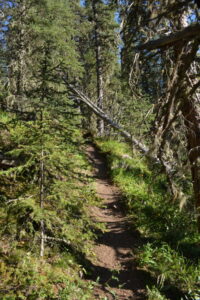 These unofficial trails can also be found all over the crown land areas. Of course, the larger OHV trails are mapped and obvious, but foot trails radiate from those as well. And all along the rivers there are trails in the woods and long the banks. It’s a great place to explore this way, though I doubt conservationists are thrilled with them.
These unofficial trails can also be found all over the crown land areas. Of course, the larger OHV trails are mapped and obvious, but foot trails radiate from those as well. And all along the rivers there are trails in the woods and long the banks. It’s a great place to explore this way, though I doubt conservationists are thrilled with them.
For more eager (or fitter) campers, these trails can take you up into the surrounding mountains. These longer treks should reward you with lovely views of the nearby valleys and ranges. There are many geocaches hidden up there as well. We found a couple on the flats and closer to the highway but the longer, more difficult treks are sure to thrill avid cachers and hikers.
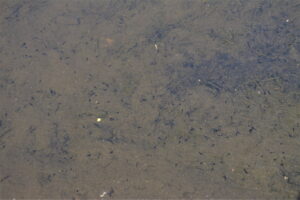 The most unexpected faunal discover were tadpoles. That’s not something we’ve regularly witnessed when camping. In a couple isolated puddles up on that inclined sandstone beside the river, there were dozens of little, black tadpoles swimming around. A nifty discovery and smart on the frogs’ part as they were isolated from the hungry fish.
The most unexpected faunal discover were tadpoles. That’s not something we’ve regularly witnessed when camping. In a couple isolated puddles up on that inclined sandstone beside the river, there were dozens of little, black tadpoles swimming around. A nifty discovery and smart on the frogs’ part as they were isolated from the hungry fish.
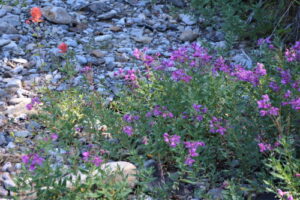 Wildflowers, on the other hand, are plentiful. The river bars are awash in colour. And the forest immediately behind our campsite had these ground-hugging white flowers that glowed in the moonlight. They were a lovely, if spooky, sight.
Wildflowers, on the other hand, are plentiful. The river bars are awash in colour. And the forest immediately behind our campsite had these ground-hugging white flowers that glowed in the moonlight. They were a lovely, if spooky, sight.
If I may take another moment to soapbox, I was disappointed at the damage to trees we saw. Every site showed the scars of people hacking off bark to light fires. And not just a small chunk here or there, whole circumferences of trunks were stripped of bark. Nails and ropes were left on some trees from hastily removed tarps.
 It’s frustrating to see this kind of damage. We protect so little of the wilderness, even less if the government has its way, and we still have campers showing so little regard for nature. But I suppose I should expect no less considering the barbed-wire fence enclosing Livingstone Falls Provincial Recreation Area was wrapped around trees and otherwise stuck (and grown over). If the parks service is this uncaring, why would patrons be any different. Pisses me off.
It’s frustrating to see this kind of damage. We protect so little of the wilderness, even less if the government has its way, and we still have campers showing so little regard for nature. But I suppose I should expect no less considering the barbed-wire fence enclosing Livingstone Falls Provincial Recreation Area was wrapped around trees and otherwise stuck (and grown over). If the parks service is this uncaring, why would patrons be any different. Pisses me off.
My son and I had a great two days at Livingstone Falls Provincial Recreation Area despite the disappointments and discomforts. I can easily see how this type of campground would be a target for cost-cutting, conservative governments. That’s unfortunate.
It could be a fantastic campground with some investment. If I were in charge, I’d make it bigger. Tack on some of that endless crown land and add some campsites. Install some better designed pit toilets that don’t turn themselves into fly graveyards. Better cleaning wouldn’t hurt either. And some day use picnic spots would compliment the day use parking lot nicely. This could be just as nice a campground as Etherington Creek and Cataract Creek north of here.
I’m not sure how to rate Livingstone Falls Provincial Recreation Area. There are those who will mourn its loss and rightly so. There are those who won’t give a fig and rightly so. I’m glad I got to enjoy it before it’s gone. I’ll give it 2.5 out of 5 Baby Dill Pickles. I’d easily rate it higher (love me some night sky and rocks), but the toilet-fly fiasco won’t let me. Ugh, that was gross.

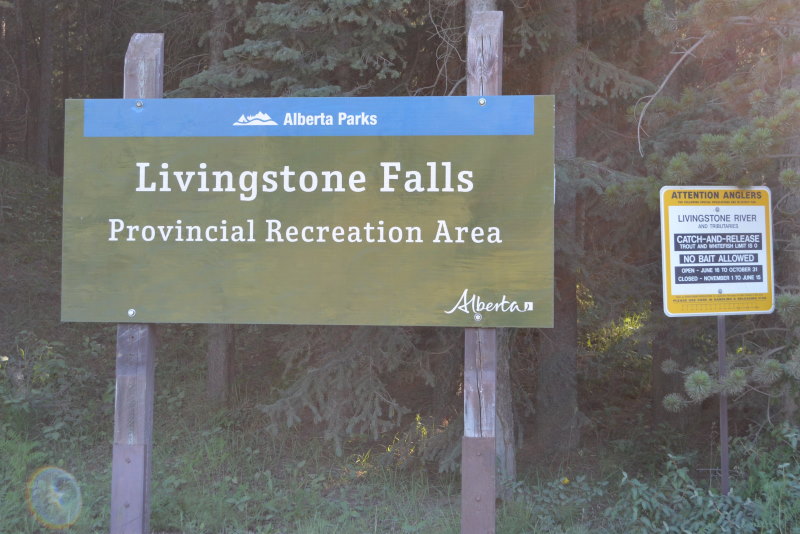













Enjoyable review once again! Lots of chuckles and head nodding in agreement. We just had a week at chinook Lake and I can well imagine the literary tales you could weave about that place! If I was more talented I would try. But I’ll wait until you go there and review it. Maybe next year? The highlights would certainly involve pit toilets *aka fly graveyards*, teenage boys in charge of cleaning them. Also roads with 90 degree angles and washboard down to the lake. Horseflies that carry you away and bite at the same time. Hordes of non social distancing beach goers. Except there was no beach — just a sand bar. Teenagers shooting off fireworks at midnight on the dam at the end of the lake. The local kids is my guess. And oh…a beautiful, calm, serene lake with the towering Crowsnest Mountain hovering over it. The good and the bad. You should go. Cheers!
Don’t underestimate yourself, that short summary review was just peachy.
I’m old enough that fireworks were illegal. A forboden indulgence snuck across the border by vacationing Canucks. I still have kneejerk, THAT’S ILLEGAL, reactions when I hear them. lol